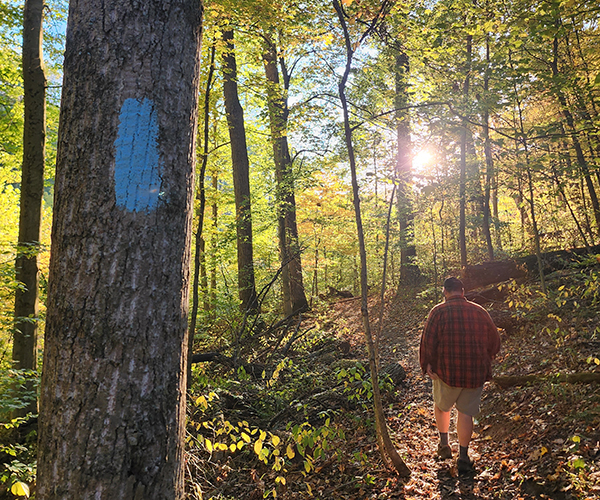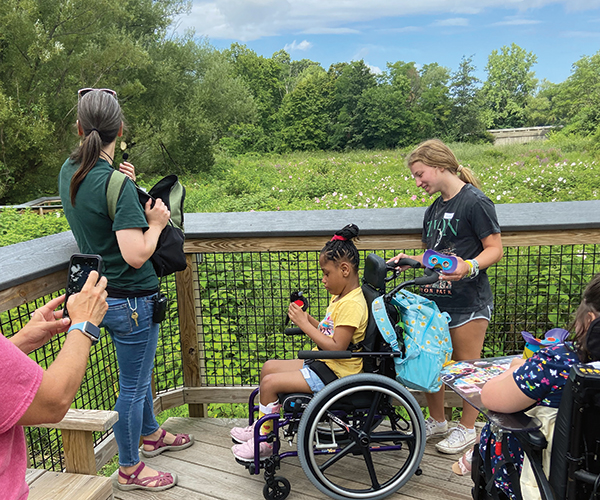Once Labor Day has come and gone, the crowds disappear from Mackinac Island.
What a treat.
We Michiganians love showing off the state’s biggest tourist attraction to out-of-towners. We love the energy summer crowds carry with them on the ferry and across the Straits of Mackinac to Michigan’s most famous island. But when the scores of fudgies finally turn their attentions elsewhere, locals know the best is yet to come. (Fudgies, as any Mackinac vet will tell you, are the tourists drawn to the gourmet fudge shops that pepper the island.) Those who dare to venture north get all of that autumn beauty to themselves.
What a treat.
We Michiganians love showing off the state’s biggest tourist attraction to out-of-towners. We love the energy summer crowds carry with them on the ferry and across the Straits of Mackinac to Michigan’s most famous island. But when the scores of fudgies finally turn their attentions elsewhere, locals know the best is yet to come. (Fudgies, as any Mackinac vet will tell you, are the tourists drawn to the gourmet fudge shops that pepper the island.) Those who dare to venture north get all of that autumn beauty to themselves.
My first autumn island escape came in 1983, when a friend invited my boyfriend and me to attend her Mackinac Island wedding in October. “This will be fun,” we told each other. “The colors will be beautiful!” But, niceties aside, we knew in our hearts that an autumn weekend in the middle of Lake Huron would be wet, windy and cold. We packed our heavy jackets, gloves and hats in silence and prepared for the worst.
But the truth is that we had never seen Mackinac Island more beautiful than on that October weekend. The water and breeze were warm. The island’s maple and oak stands were just beginning to turn shades of yellow, orange and red. And my ivory-clad friend was never more beautiful than on that sunny autumn day, with the burgundy Grand Hotel carriage delivering her to the Little Stone Church — and with few tourists to block her way. The weekend proved so magical that my boyfriend proposed to me, and today he is my husband.
Since that first autumn visit, I’ve returned to the island many times to prove my first impression was more than a fluke. Mackinac Island (pronounced Mackinaw), known for its cool summers, enjoys some of Michigan’s finest autumn weather. After a long and bitter winter, Lake Huron’s cold water takes months to warm up, and until that happens the island’s weather suffers. But by early September, the Great Lakes have soaked up a whole summer’s worth of heat and sunshine. Oh, sure, evenings can grow nippy. And there’s a crisp scent to the air, reminding visitors that these golden days cannot last. But for a little while, Lake Huron’s breezes and Mackinac Island’s stony beaches remain warm. Most travelers never enjoy them.
But the truth is that we had never seen Mackinac Island more beautiful than on that October weekend. The water and breeze were warm. The island’s maple and oak stands were just beginning to turn shades of yellow, orange and red. And my ivory-clad friend was never more beautiful than on that sunny autumn day, with the burgundy Grand Hotel carriage delivering her to the Little Stone Church — and with few tourists to block her way. The weekend proved so magical that my boyfriend proposed to me, and today he is my husband.
Since that first autumn visit, I’ve returned to the island many times to prove my first impression was more than a fluke. Mackinac Island (pronounced Mackinaw), known for its cool summers, enjoys some of Michigan’s finest autumn weather. After a long and bitter winter, Lake Huron’s cold water takes months to warm up, and until that happens the island’s weather suffers. But by early September, the Great Lakes have soaked up a whole summer’s worth of heat and sunshine. Oh, sure, evenings can grow nippy. And there’s a crisp scent to the air, reminding visitors that these golden days cannot last. But for a little while, Lake Huron’s breezes and Mackinac Island’s stony beaches remain warm. Most travelers never enjoy them.
During one trip, my husband and I headed west along M-185, Michigan’s sole bicycle, horse and pedestrian-only highway. Our goal was to circumnavigate the island on two wheels, enjoying the autumn color of the straits from every possible vantage point. The eight-mile route made for easy bicycling, set as it is along the island’s lakeshore. The smaller crowds made for easy rubbernecking. Yellow and orange maple leaves glowed in the autumn sun, contrasting brilliantly with the deep blues of Lake Huron, and the graceful arch of the Mackinac Bridge, spanning the Upper and Lower peninsulas, filled views to the west.
Once we had circled the island, we pointed our bicycles toward Fort Mackinac. The oldest structure in Michigan, and one of the nation’s few remaining Revolutionary War-era landmarks, Fort Mackinac looms high on a bluff overlooking the straits. Originally a British outpost, the fort hosts regular bugle and drum corps performances, cannon firings and military reenactments. We explored the 18th-century ruins and interpretive center. But most of our time was spent admiring the autumn colors on the mainland, easily visible from our bluff-top location.
After Fort Mackinac, we pedaled farther inland, past Skull Cave to Fort Holmes. Earthen berms and a historic plaque mark the location of the fort, established by the British during the War of 1812. But the ride to Mackinac Island’s highest point is worth the effort for no other reason than the views. To the north and south lie Michigan’s Upper and Lower peninsulas, awash with the colors of October.
After we had our fill, it was all downhill to Main Street, Mackinac Island’s downtown. Shop owners reduce their hours in autumn, replacing their summertime work duties with preparations for the coming winter. But when we visited, most were still open, the shopkeepers friendly and well-rested.
Once we had circled the island, we pointed our bicycles toward Fort Mackinac. The oldest structure in Michigan, and one of the nation’s few remaining Revolutionary War-era landmarks, Fort Mackinac looms high on a bluff overlooking the straits. Originally a British outpost, the fort hosts regular bugle and drum corps performances, cannon firings and military reenactments. We explored the 18th-century ruins and interpretive center. But most of our time was spent admiring the autumn colors on the mainland, easily visible from our bluff-top location.
After Fort Mackinac, we pedaled farther inland, past Skull Cave to Fort Holmes. Earthen berms and a historic plaque mark the location of the fort, established by the British during the War of 1812. But the ride to Mackinac Island’s highest point is worth the effort for no other reason than the views. To the north and south lie Michigan’s Upper and Lower peninsulas, awash with the colors of October.
After we had our fill, it was all downhill to Main Street, Mackinac Island’s downtown. Shop owners reduce their hours in autumn, replacing their summertime work duties with preparations for the coming winter. But when we visited, most were still open, the shopkeepers friendly and well-rested.
Grand Hotel closes its Victorian halls for winter, too, but not before paying meticulous attention to its final visitors of the year. The 1887 National Historic Landmark is known for treating its guests like royalty. The smaller crowds of September and October allow the staff just a little more interaction with visitors.
Grand Hotel’s veranda, outfitted with dozens of wooden rocking chairs, stands as a focal point of the wood-frame structure. It also serves as the perfect backdrop for enjoying views of the property’s autumnal flowering plants. Inside, each morning begins with a hot breakfast in the hotel’s main dining room, followed by afternoon tea and an evening dinner there or at the Bavarian-themed Woods restaurant. A horse-drawn carriage transports guests to Woods through a tunnel of vivid hardwood trees. In autumn, passengers relax under a wool blanket in the crisp evening air. The crunch of gravel under the carriage wheels and the clip-clop of horses’ hooves are the only sounds.
There are few signs of people on Mackinac Island’s rural roads this time of year, preserving a tranquil silence. You’ll get used to it.
[If you go]
For more details about Mackinac Island in any season, including attractions, information and ferry schedules, contact the Mackinac Island Tourism Bureau at 1-877-847-0086 or mackinacisland.org. For information about the Grand Hotel, including details on discounted fall packages, visit grandhotel.com or call 1-800-334-7263.
Grand Hotel’s veranda, outfitted with dozens of wooden rocking chairs, stands as a focal point of the wood-frame structure. It also serves as the perfect backdrop for enjoying views of the property’s autumnal flowering plants. Inside, each morning begins with a hot breakfast in the hotel’s main dining room, followed by afternoon tea and an evening dinner there or at the Bavarian-themed Woods restaurant. A horse-drawn carriage transports guests to Woods through a tunnel of vivid hardwood trees. In autumn, passengers relax under a wool blanket in the crisp evening air. The crunch of gravel under the carriage wheels and the clip-clop of horses’ hooves are the only sounds.
There are few signs of people on Mackinac Island’s rural roads this time of year, preserving a tranquil silence. You’ll get used to it.
[If you go]
For more details about Mackinac Island in any season, including attractions, information and ferry schedules, contact the Mackinac Island Tourism Bureau at 1-877-847-0086 or mackinacisland.org. For information about the Grand Hotel, including details on discounted fall packages, visit grandhotel.com or call 1-800-334-7263.



